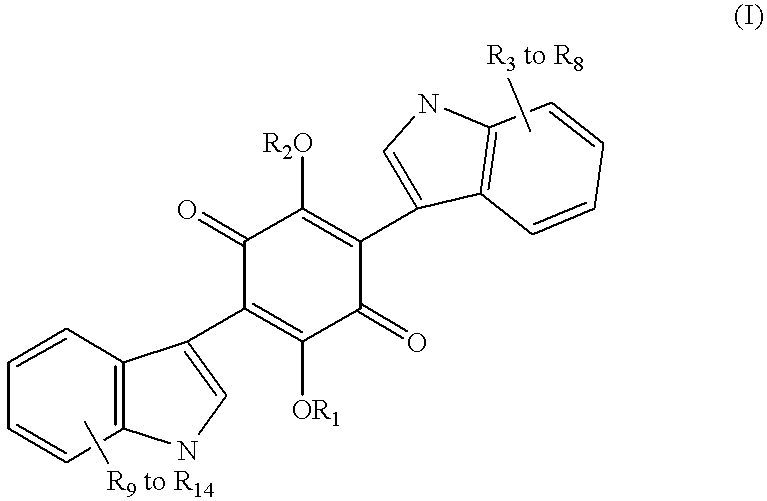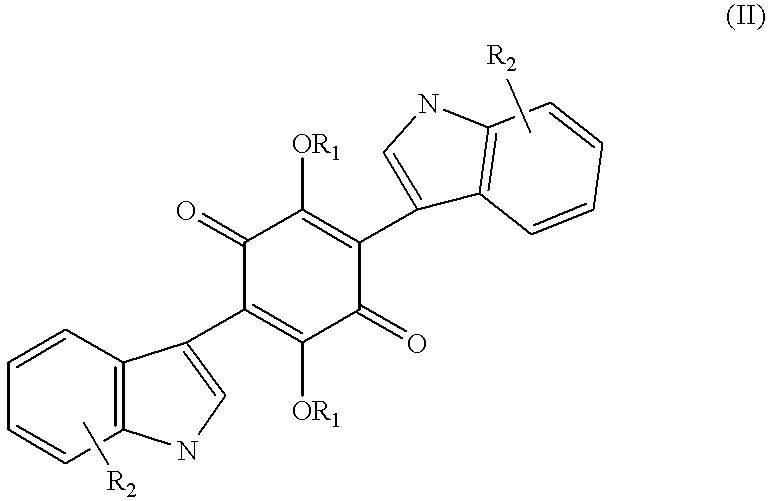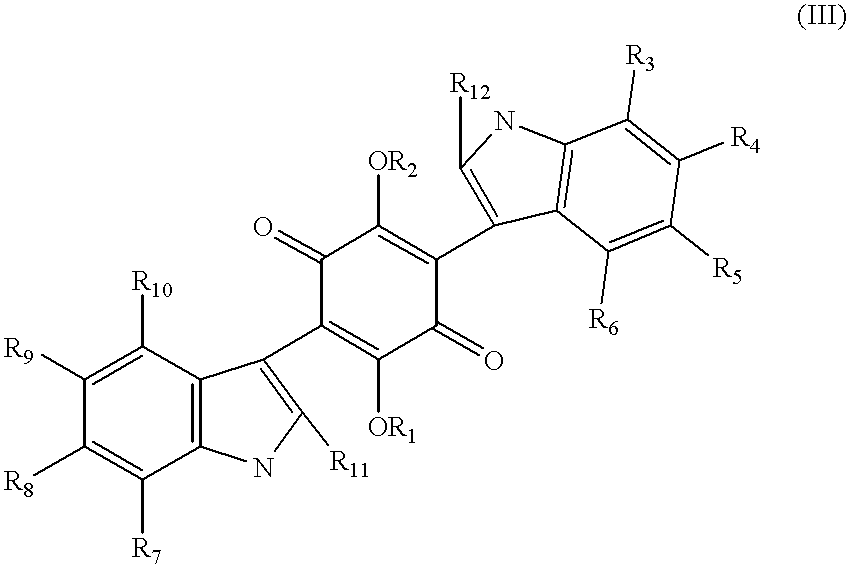Method and compositions for inhibition of adaptor protein/tyrosine kinase interactions
a technology of adaptor protein and tyrosine kinase, which is applied in the direction of drug compositions, biocide, heterocyclic compound active ingredients, etc., can solve the problem that no such inhibitor of adaptor protein/protein tyrosine kinase interaction has been identified
- Summary
- Abstract
- Description
- Claims
- Application Information
AI Technical Summary
Problems solved by technology
Method used
Image
Examples
example 1
2,5-Dihydroxy-3,6-di-[2-(2-methylbut-2-en-4-yl)indol-3-yl]1,4-quinone
A mixture of 100 mg. of 2,5-diacetoxy-3,6-dibromo-1,4-quinone, or other suitably protected quinone such as 3,6-dibromo-2,5-ditrimethylsiloxy-1,4-quinone, 3,6-dibromo-2,5-di-(t-butyldimethylsiloxy-1,4-quinone, 2,5-dibenzoxy-3,6-dibromo-1,4-quinone, 3,6-dibromo-2,5-diisobutryoxy-1,4-quinone, 2,5-dibenzyloxy-3,6-dibromo-1,4-quinone or 2,5-diallyoxycarbonyloxy-3,6-dibromo-1,4-quinone which can be prepared from commercially available 2,4-dibromo-3,6-dihydroxy-1,4-quinone and 180 mg of 3-[2-(2-methylbut-2-en-4-yl)indole, prepared by the Fisher indole synthesis, in 10 ml of anhydrous dimethylforamide, or pyridine or dimethylsulfoxide, with powdered potassium carbonate, was heated at 100.degree. C. for 24 hours. The cooled mixture was partitioned between ethyl acetate and water. The ethyl acetate layer was then washed with brine, dried over sodium sulfate, filtered and concentrated. The crude was then purified on a medium ...
example 2
2,5-Diacetoxy-3,6-di-[2-(2-methylbut-2-en-4-yl)indol-3-yl]1,4-quinone
2,5-Diacetoxy-3,6-di-(2-(2-methylbut-2-en-4-yl)indol-3-yl]1,4-quinone was prepared in Example 1.
example 3
2,5-Diacetoxy-3,6-di-[2(3-methyl-n-butyl)indol-3-yl]1,4-quinone
Hydrogenation of 2,5-diacetoxy-3,6-di-[2-(2-methylbut-2-en-4-yl)indol-3-yl]1,4-quinone in methanol with 5% palladium on carbon under 1 atm of hydrogen produced the title compound.
PUM
| Property | Measurement | Unit |
|---|---|---|
| melting point | aaaaa | aaaaa |
| temperature | aaaaa | aaaaa |
| OD | aaaaa | aaaaa |
Abstract
Description
Claims
Application Information
 Login to View More
Login to View More - R&D
- Intellectual Property
- Life Sciences
- Materials
- Tech Scout
- Unparalleled Data Quality
- Higher Quality Content
- 60% Fewer Hallucinations
Browse by: Latest US Patents, China's latest patents, Technical Efficacy Thesaurus, Application Domain, Technology Topic, Popular Technical Reports.
© 2025 PatSnap. All rights reserved.Legal|Privacy policy|Modern Slavery Act Transparency Statement|Sitemap|About US| Contact US: help@patsnap.com



